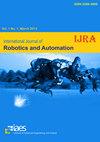Design of RTD-PID optimized neural networks controller for non-holonomic wheeled mobile robot
IF 1
4区 计算机科学
Q4 AUTOMATION & CONTROL SYSTEMS
International Journal of Robotics & Automation
Pub Date : 2019-09-26
DOI:10.15406/iratj.2019.05.00191
引用次数: 0
Abstract
In fact, many efforts have been devoted to the tracking control of the two-wheeled and non-holonomic mobile robots and many types of controllers were applied to overcome trajectory tracking problems. Some of them have been investigated based on conventional methods using PID control,2,3 robust control,4,5 sliding mode control,6–8 adaptive control.9,10 The others are based on artificial intelligence using fuzzy control11–13 and neural control.14–16 In fact, neural networks are recommended for intelligent control of nonlinear dynamic systems. Principally, this is due to two important properties of neural networks: their ability to learn, and their good performance for optimization. Nowadays, much attention is devoted to the use of neural networkbased control of mobile robots for trajectory following. The principle of the method is based on a multilayer feed-forward neural networks with back-propagation learning algorithm, and it has been shown that only one hidden layer can be largely sufficient to approximate any continuous functions. In,3 a PID-based neural network is developed for velocity and orientation, tracking control of a non-holonomic mobile robot that is appropriate for a kind of plant with nonlinearity uncertainties and disturbances.非完整轮式移动机器人RTD-PID优化神经网络控制器设计
事实上,人们对两轮非完整移动机器人的跟踪控制做了大量的研究,并应用了多种类型的控制器来克服轨迹跟踪问题。其中一些在传统方法的基础上进行了研究,包括PID控制、2,3鲁棒控制、4,5滑模控制、6-8自适应控制。9,10其他的则是基于人工智能,使用模糊控制11 - 13和神经控制。事实上,神经网络被推荐用于非线性动态系统的智能控制。这主要是由于神经网络的两个重要特性:它们的学习能力和良好的优化性能。目前,基于神经网络的移动机器人轨迹跟踪控制受到了广泛的关注。该方法的原理是基于多层前馈神经网络和反向传播学习算法,并且已经证明只需一个隐藏层就足以近似任何连续函数。本文提出了一种基于pid的非完整移动机器人的速度和方向跟踪控制方法,该方法适用于一类具有非线性不确定性和干扰的对象。
本文章由计算机程序翻译,如有差异,请以英文原文为准。
求助全文
约1分钟内获得全文
求助全文
来源期刊
CiteScore
1.20
自引率
44.40%
发文量
71
审稿时长
8 months
期刊介绍:
First published in 1986, the International Journal of Robotics and Automation was one of the inaugural publications in the field of robotics. This journal covers contemporary developments in theory, design, and applications focused on all areas of robotics and automation systems, including new methods of machine learning, pattern recognition, biologically inspired evolutionary algorithms, fuzzy and neural networks in robotics and automation systems, computer vision, autonomous robots, human-robot interaction, microrobotics, medical robotics, mobile robots, biomechantronic systems, autonomous design of robotic systems, sensors, communication, and signal processing.

 求助内容:
求助内容: 应助结果提醒方式:
应助结果提醒方式:


